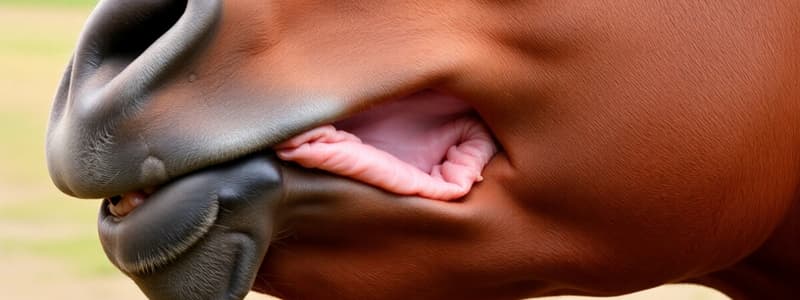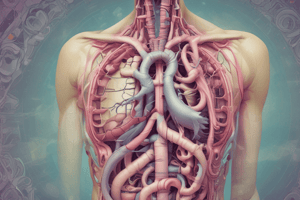Podcast
Questions and Answers
A 12-year-old Percheron presents with an esophageal obstruction. Given the bloodwork results, which of the following findings would MOST strongly suggest an element of aspiration pneumonia?
A 12-year-old Percheron presents with an esophageal obstruction. Given the bloodwork results, which of the following findings would MOST strongly suggest an element of aspiration pneumonia?
- Slightly elevated anion gap due to dehydration and poor perfusion
- Elevated total protein due to increased globulins and fibrinogen (correct)
- Hyperglycemia as a stress response to esophageal obstruction
- Hypochloremia resulting from the loss of saliva due to obstruction
In the 12-year-old Percheron with esophageal obstruction, the bloodwork reveals hyperglycemia. What is the MOST likely underlying cause of this hyperglycemia?
In the 12-year-old Percheron with esophageal obstruction, the bloodwork reveals hyperglycemia. What is the MOST likely underlying cause of this hyperglycemia?
- The hyperglycemia is a physiological stress response to the obstruction (correct)
- The horse has an undiagnosed case of equine metabolic syndrome
- The esophageal obstruction directly impairs glucose metabolism
- The obstruction has caused insulin resistance
A 12-year-old Percheron with esophageal obstruction shows hypochloremia on bloodwork. How does esophageal obstruction lead to decreased chloride levels?
A 12-year-old Percheron with esophageal obstruction shows hypochloremia on bloodwork. How does esophageal obstruction lead to decreased chloride levels?
- The obstruction leads to decreased chloride absorption in the intestines
- The horse is losing chloride-rich saliva due to the esophageal obstruction (correct)
- The esophageal obstruction causes increased renal excretion of chloride
- The obstruction is causing a shift of chloride into the intracellular space
In the case of the Percheron with esophageal obstruction, which bloodwork parameter is MOST indicative of dehydration?
In the case of the Percheron with esophageal obstruction, which bloodwork parameter is MOST indicative of dehydration?
Given the provided lab results for the 12-year-old Percheron, what would be the MOST appropriate next step?
Given the provided lab results for the 12-year-old Percheron, what would be the MOST appropriate next step?
A 5-year-old Quarter Horse gelding recovering from S. equi (strangles) infection has a PCV of 14% and total protein of 7.9 g/dL. Immunologic testing reveals a positive Coombs test, with IgA and IgG identified on the surface of RBCs. What is the MOST likely cause of the anemia?
A 5-year-old Quarter Horse gelding recovering from S. equi (strangles) infection has a PCV of 14% and total protein of 7.9 g/dL. Immunologic testing reveals a positive Coombs test, with IgA and IgG identified on the surface of RBCs. What is the MOST likely cause of the anemia?
Considering the 5-year-old Quarter Horse gelding's condition (PCV 14%, total protein 7.9 g/dL, Coombs positive), which treatment strategy is MOST appropriate?
Considering the 5-year-old Quarter Horse gelding's condition (PCV 14%, total protein 7.9 g/dL, Coombs positive), which treatment strategy is MOST appropriate?
In the 5-year-old Quarter Horse gelding recovering from strangles with a PCV of 14%, under what circumstance would a blood transfusion be MOST strongly indicated?
In the 5-year-old Quarter Horse gelding recovering from strangles with a PCV of 14%, under what circumstance would a blood transfusion be MOST strongly indicated?
Given a two-day-old foal presents with a PCV of 12% and total protein of 6.8 g/dL and a history of not nursing, what is the MOST likely cause of this presentation?
Given a two-day-old foal presents with a PCV of 12% and total protein of 6.8 g/dL and a history of not nursing, what is the MOST likely cause of this presentation?
In the case of the two-day-old foal with suspected neonatal isoerythrolysis, why is using the mare as a blood donor appropriate?
In the case of the two-day-old foal with suspected neonatal isoerythrolysis, why is using the mare as a blood donor appropriate?
Three day old foal, what is the MOST crucial initial step in managing a three-day-old foal diagnosed with neonatal isoerythrolysis (NI) after initial stabilization?
Three day old foal, what is the MOST crucial initial step in managing a three-day-old foal diagnosed with neonatal isoerythrolysis (NI) after initial stabilization?
Referring to the Percheron case, aside from the loss of chloride, what is another acid-base disturbance that is linked to hypochloremia?
Referring to the Percheron case, aside from the loss of chloride, what is another acid-base disturbance that is linked to hypochloremia?
Why is alkaline phosphatase (ALP) elevated during severe obstructive conditions?
Why is alkaline phosphatase (ALP) elevated during severe obstructive conditions?
Total protein in the Percheron case is elevated. The globulins and fibrinogen are elevated as well due to inflammation. What is a different condition other than aspiration pneumonia that can cause this elevation?
Total protein in the Percheron case is elevated. The globulins and fibrinogen are elevated as well due to inflammation. What is a different condition other than aspiration pneumonia that can cause this elevation?
According to the documentation given, the patient is only slightly elevated in anion gap in the Percheron case. What does this possibly indicate?
According to the documentation given, the patient is only slightly elevated in anion gap in the Percheron case. What does this possibly indicate?
When would you consider a blood transfusion when a patient tests positively for the coombs test?
When would you consider a blood transfusion when a patient tests positively for the coombs test?
When dealing with a foal, what is the ideal blood donor choice?
When dealing with a foal, what is the ideal blood donor choice?
Why can Neonatal Isoerythrolysis still be a problem?
Why can Neonatal Isoerythrolysis still be a problem?
In the Percheron case with esophageal obstruction, why is it important to check blood levels?
In the Percheron case with esophageal obstruction, why is it important to check blood levels?
In the foal case, what surface antibody testing had to be done?
In the foal case, what surface antibody testing had to be done?
Flashcards
Elevated PCV Interpretation
Elevated PCV Interpretation
Elevated PCV may indicate relative polycythemia due to dehydration from esophageal obstruction and stress.
Elevated Total Protein Cause
Elevated Total Protein Cause
Increased globulins and fibrinogen often point to inflammation, possibly aspiration pneumonia related to esophageal obstruction.
Hyperglycemia Cause in Horses
Hyperglycemia Cause in Horses
Hyperglycemia in horses is often a physiological response to stress, such as that caused by esophageal obstruction.
Hypochloremia Cause
Hypochloremia Cause
Signup and view all the flashcards
Elevated Anion Gap Significance
Elevated Anion Gap Significance
Signup and view all the flashcards
Elevated Alkaline Phosphatase Significance
Elevated Alkaline Phosphatase Significance
Signup and view all the flashcards
Low PCV Interpretation
Low PCV Interpretation
Signup and view all the flashcards
Treatment Approach for Stable Anemia
Treatment Approach for Stable Anemia
Signup and view all the flashcards
PCV of 12% in Foal
PCV of 12% in Foal
Signup and view all the flashcards
Likely cause of Anemia
Likely cause of Anemia
Signup and view all the flashcards
Neonatal Isoerythrolysis Treatment
Neonatal Isoerythrolysis Treatment
Signup and view all the flashcards
Study Notes
- 12-year-old Percheron had an esophageal obstruction with distress at presentation.
- The patient's temperature was 102°F, pulse was 64 BPM, and respiratory rate was 30 BrPM.
- CBC and chemistry tests were performed for the horse.
Interpreting Hematocrit (HCT = PCV)
- Elevated PCV suggests relative polycythemia, possibly due to dehydration and stress from esophageal obstruction.
- The horse has 47 PCV, which is higher than the normal ~35%; this elevation should resolve with obstruction correction and fluid therapy.
Interpreting Total Protein Concentration
- Elevated total protein (TP) is due to increased globulins and fibrinogen, suggesting inflammation.
- Potential causes include aspiration pneumonia from the esophageal obstruction or a pre-existing issue like dental disease.
- Treatment of the primary condition along with monitoring helps determine the need for supplementary diagnostics.
Hyperglycemia
- Esophageal obstruction causes physiological stress and hyperglycemia.
- Resolving the obstruction should resolve hyperglycemia.
Hypochloremia
- Equine saliva is high in chloride.
- Esophageal obstruction causes a loss of saliva, leading to hypochloremia and corresponding metabolic alkalosis.
- Bicarbonate levels are at 33 mmol/L.
Significance of Anion Gap
- The mildly elevated anion gap (21 mmol/L, reference up to 19 mmol/L) is likely due to dehydration and poor peripheral perfusion.
- Poor perfusion leads to anaerobic glycolysis and lactate production.
Significance of Alkaline Phosphatase
- A change here is not clinically significant.
- Elevated alkaline phosphatase is attributed to poor peripheral perfusion, tissue hypoxia, and liver damage in the case.
Case Example: 5 YO QH Gelding
- A 5-year-old Quarter Horse gelding is recovering from respiratory disease, diagnosed as S. equi (strangles).
- The patient is stable with adequate vitals indicating a temperature of 99.7°F, a pulse of 52 BPM, and a respiratory rate of 20 BrPM, along with adequate appetite.
- PCV measures 14%, with total protein noted to be 7.9 g/dL.
- Immunologic testing was Coombs positive, and flow cytometry identified IgA and IgG on RBC surfaces.
Blood Transfusion
- Coombs-positive immunologic testing indicates IgA and IgG, pointing to immune-mediated hemolytic anemia.
- A blood transfusion is not currently indicated as per the stable vital signs and 14% PCV.
- Steroids are to be administered to treat the primary issue.
- Blood transfusion would be indicated should the patient's condition worsen.
Case Example: Two Day Old Foal
- A two-day-old foal is presented for not being able to nurse.
- Examination reveals a temperature of 101.5°F (normal range: 99-101.5°F), a pulse of 90 BPM, and a respiratory rate of 44 BrPM.
- The foal’s PCV is 12%, and total protein is 6.8 g/dL.
Problems and Working Diagnosis
- A three-day-old foal, born to a multi-parous mare, presents with severe anemia and normal total protein levels.
- Neonatal isoerythrolysis is a likely diagnosis, confirmed via Coomb's test and surface antibody testing.
- A blood transfusion is warranted, with the maternal red blood cells (without plasma) being an ideal solution.
- Multiple transfusions can be required to reach adequate circulating RBC levels.
Studying That Suits You
Use AI to generate personalized quizzes and flashcards to suit your learning preferences.




